Emerald cut diamonds have a timeless elegance. Their sophisticated shape and unique, flashing facets give them a chic, unforgettable beauty. But when shopping for an emerald cut diamond, there are some special considerations to keep in mind. In this post, we’ll discuss all our top tips for buying an emerald cut diamond to help you pick the emerald cut diamond that’s right for you. We’ll cover what defines the emerald cut, what to look for when considering emerald cut diamond qualities, emerald cut diamond prices, and which setting styles are the most popular for emerald cut diamonds.
Know the Cut: What is An Emerald Cut Diamond?
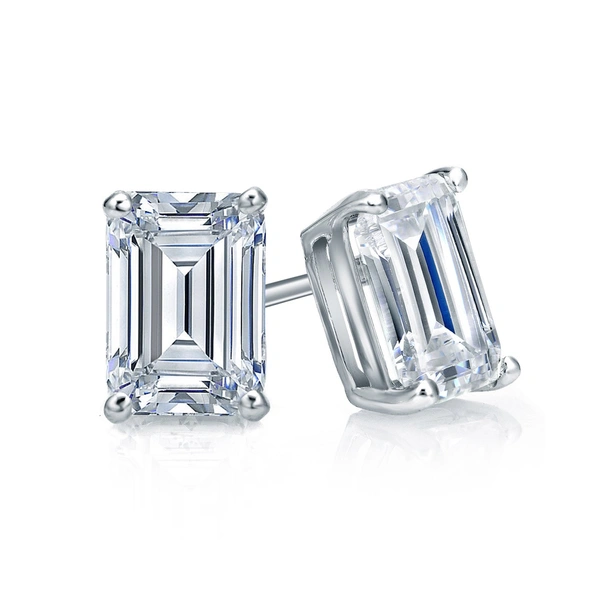
Emerald Cut Diamond 4-Prong Basket Stud Earrings
Emerald cut diamonds are shaped like rectangles with cut corners. Like many other diamond shapes, emerald cut diamonds have 57 or 58 facets. But unlike most other diamond shapes, the facets on an emerald cut diamond are step cut, rather than brilliant cut. Step cut facets are larger, more linear facets that are arranged symmetrically. The step cuts of an emerald cut diamond are what give it its signature flashing, “hall of mirrors” effect.
Emerald cut diamonds are often confused for asscher cut diamonds and radiant cut diamonds. The asscher cut diamond is also rectangular and step cut, but you can tell it apart from an emerald cut diamond by noting the asscher cut’s X-shaped facet pattern that runs across its table. Radiant diamonds share the same shape as emerald cut diamonds (rectangular with cut corners) but are brilliant cut, so they don’t feature the same symmetrical, linear facets of emerald cut diamonds.
The 4Cs of Emerald Cut Diamonds
Understanding the 4Cs (clarity, cut, color, and carat) of diamonds is important before buying any diamond. But with emerald cut diamonds, there are some special considerations you should keep in mind. In this next section, we’ll cover the 4Cs of emerald cut diamonds and tell you everything you need to know about emerald cut diamond qualities so you can make an informed choice when buying.
Clarity is Key for Emerald Cut Diamonds
While most experts agree that cut is the most important diamond quality across all diamond shapes, clarity is also very important in emerald cut diamonds. The step cuts of the emerald diamond allow you to see more clearly into the center of the diamond. This gives emerald cut diamonds a unique beauty, but can also make internal flaws much easier to see. So, when buying an emerald cut diamond, you should consider selecting one with a higher clarity grade.
Cut and Emerald Cut Diamonds
Cut is important for every diamond shape and emerald cut diamonds are no exception. Cut is a grading of how well a diamond is cut. If a diamond is cut poorly, it won’t reflect and refract light well, making it look dull and lifeless. So, just like with every other diamond shape, don’t sacrifice on cut when selecting an emerald cut diamond.
Carat Weight and Emerald Cut Diamonds
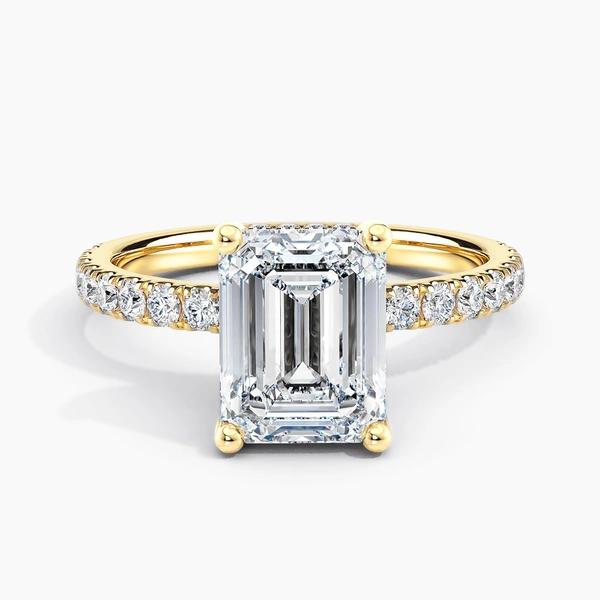
Classic Hidden Halo Engagement Ring
While many people think that carat is a measurement of a diamond’s size, diamond carat is actually a weight measurement. However, diamond carat can give you an idea of the size of a diamond, as the heavier it is, the more mass it will have.
One advantage of emerald cut diamonds is that they look larger per carat than many other diamond shapes, due to having more of their surface area on their table (the top of the diamond). So, a 1 carat emerald diamond will usually look larger than a 1 carat round diamond.
Color and Emerald Cut Diamonds
For emerald cut diamonds, you should think about color in the same way you would with any other diamond shape. As with other diamond shapes, there’s really no “right” color to choose when selecting an emerald cut diamond. D, E, and F color emerald diamonds will be the most colorless— but also the most expensive. Because of this, many people are happy with G or H color emerald cut diamonds, which have a slightly warmer color but are still near colorless and are much less expensive.
Emerald Cut Diamond Special Consideration: Length, Width, and Depth Ratios
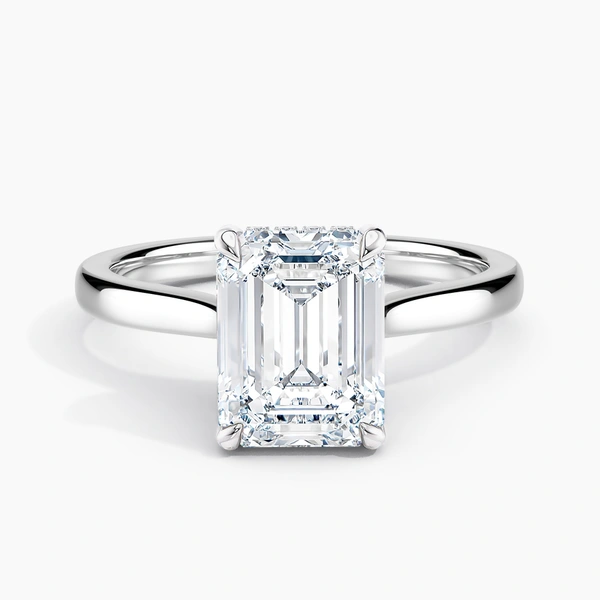
Tapered Classic Hidden Halo Engagement Ring
The length to width ratio of an emerald cut diamond can make it look either longer or more square. Generally, ratios of 1.45 to 1.55 are the most popular for emerald cut diamonds. But if you prefer a longer or more square emerald cut diamond, you can certainly get one. The length to width ratio of an emerald diamond doesn’t effect its beauty, only its shape. So, do some browsing and see which length to width ratio you love the most.
However, something that does have an effect on an emerald cut diamond’s beauty is its depth ratio. For the most brilliant emerald cut diamond, look for a depth percentage of 60% to 70% of the diamond’s width.
Emerald Cut Diamond Pricing
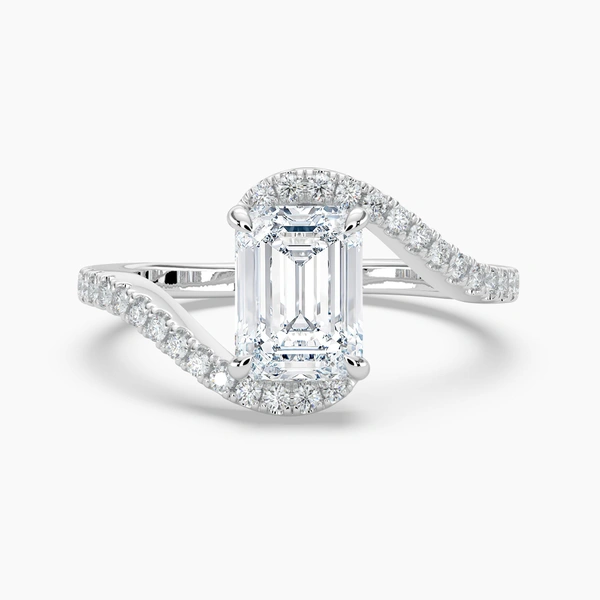
Emerald cut diamonds are one of the rarer diamond shapes, which can make them more expensive. However, their larger table surface area means they look larger per carat than many other diamond shapes. So, you can often go with a slightly lower carat to help an emerald cut diamond fit into your budget, while not necessarily sacrificing on its visual impact.
To give you a general idea of what an emerald cut diamond costs, know that a 1 carat emerald cut diamond will usually cost somewhere between $1,400 to $6,000. The cost of an emerald cut diamond, like any diamond shape, will vary greatly depending on its quality. The better the quality, the higher the price.
Emerald Cut Diamond Settings: Which Setting Style Looks the Best With Emerald Cut Diamonds?
Choosing a setting for your emerald cut diamond is really a matter of personal preference. There’s no “best” setting for an emerald cut diamond. You should simply choose the ring setting you think would pair best with your diamond.
But with that said, there are two types of settings that are the most popular for emerald cut diamonds: solitaire and halo settings. Solitaire settings let the pure beauty of an emerald cut diamond take full focus, while halo settings amp up their glamour. Of course, you don’t have to choose one of these settings if you’d prefer another style, like a three stone emerald cut engagement ring or a unique, modern style. When choosing a ring setting for an emerald cut diamond, just take some time to think about your own personal style and consider which type of setting you’d love the most.
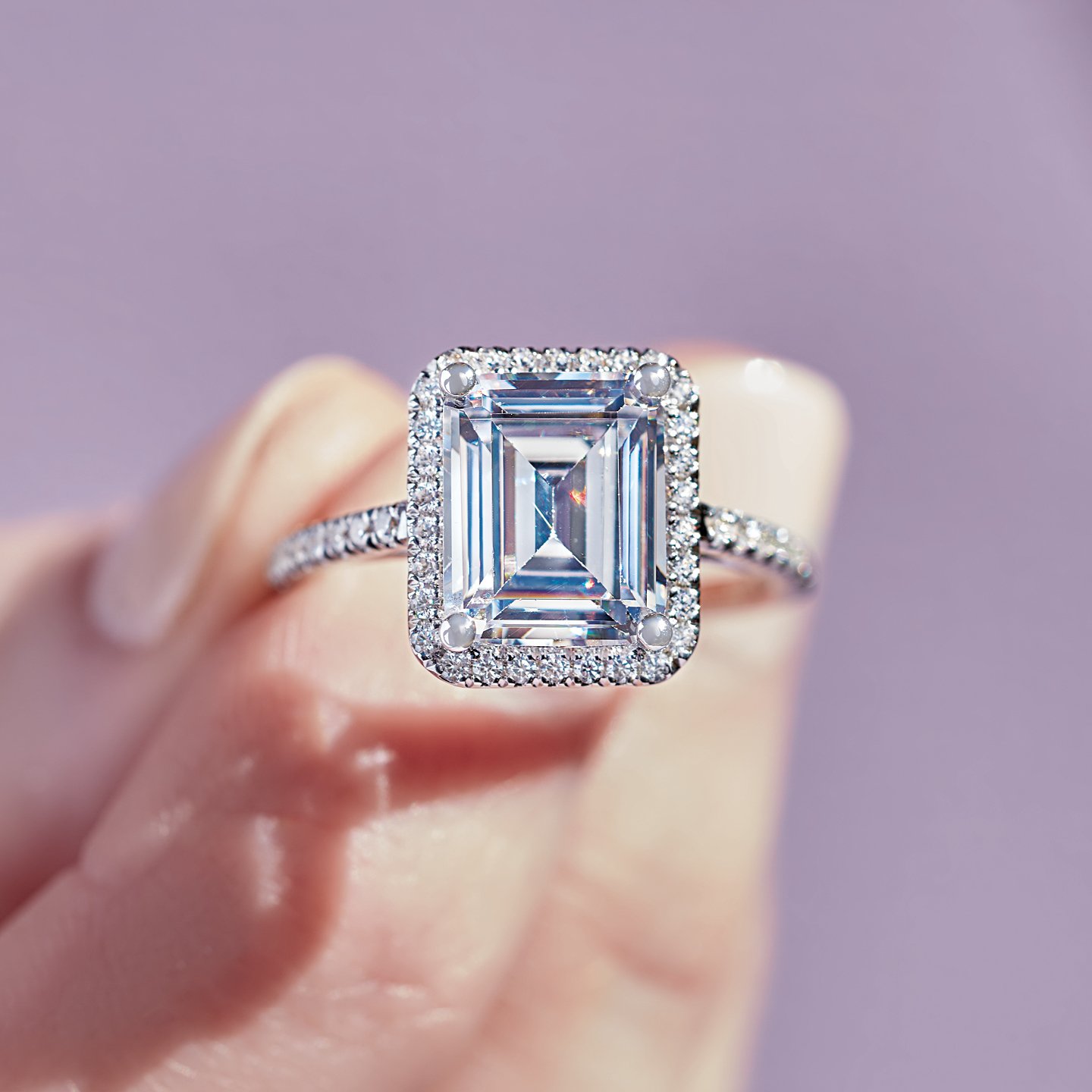
Comments are closed.